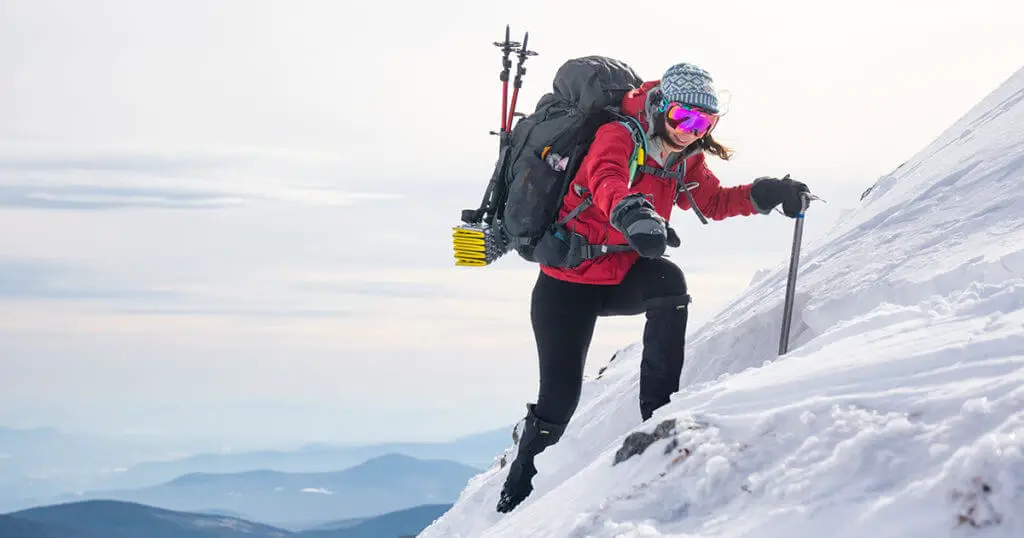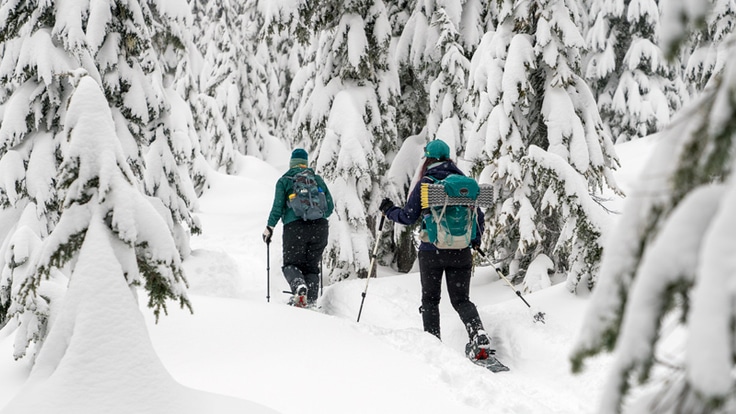For beginners, the right snowshoeing equipment includes snowshoes, trekking poles, and proper winter clothing. Investing in quality gear will enhance your outdoor experience and keep you safe on the snow-covered trails.
Snowshoeing is a fantastic way to enjoy the winter landscape and stay active during the colder months. With the right equipment and a sense of adventure, you can explore snowy terrain and experience the beauty of nature in a new way.
Whether you’re a novice or looking to take your skills to the next level, having the proper gear is key to a successful snowshoeing adventure. From choosing the right snowshoes to dressing in layers, being prepared will ensure a memorable and enjoyable experience in the winter wonderland.


Credit: bearfoottheory.com
Choosing The Right Snowshoes
Before buying snowshoes, assess the terrain you plan to explore and the snow conditions.
- Deep powder snow requires larger and more floatable snowshoes.
- For packed trails, smaller snowshoes offer better maneuverability.
To ensure a comfortable fit, snowshoes should match your weight and the gear you carry.
- Refer to the manufacturer’s sizing guide for accurate measurements.
- Consider a larger size if you carry a heavy backpack or equipment.
Essential Clothing And Layering
Proper clothing and layering are key to a comfortable and safe snowshoeing experience for beginners. Ensuring you have the right attire and layers will help keep you warm, dry, and protected from the elements throughout your adventure.
Choosing Appropriate Footwear
Selecting the right footwear for snowshoeing is crucial – opt for insulated and waterproof boots with good traction to prevent slipping. Ensure your boots fit well to avoid blisters and discomfort.
Layering For Comfort And Safety
Layering is essential to regulate body temperature and stay comfortable during your snowshoeing excursion. Start with a moisture-wicking base layer followed by an insulating layer and windproof outer shell. Don’t forget gloves, a hat, and sunglasses for added protection.
Accessories For Comfort And Safety
Elevate your snowshoeing experience with essential accessories for comfort and safety. The right equipment for beginners includes sturdy, adjustable poles, insulated waterproof boots, and high-visibility clothing. Ensure a safe and enjoyable outing with these must-have accessories.
Safety Essentials
Discover the essential snowshoeing gear that beginners need for a safe and enjoyable adventure in the snow. Equip yourself with the right equipment to navigate the winter terrain with confidence. Ensure your safety with the proper snowshoes, poles, and clothing for a successful outing.
Navigational Tools And Maps
When it comes to snowshoeing, having the right navigational tools and maps is essential for your safety. These tools will not only help you stay on the right path but also navigate through diverse terrain and changing weather conditions. Before embarking on your snowshoeing adventure, make sure to equip yourself with the following essentials:1. Compass:
A compass is a trusty tool that helps you determine directions and orient yourself in the wilderness. It is crucial for snowshoeing as it enables you to find your way back if you get lost or disoriented in snow-covered landscapes. Remember to bring a compass along with you and learn how to use it correctly before hitting the trails.2. Topographic Maps:
Topographic maps provide detailed information about the terrain, elevation, and landmarks in a specific area. These maps are highly beneficial for planning your snowshoeing route, avoiding potential hazards, and discovering scenic spots along the way. Make sure to obtain updated topographic maps of the area you intend to explore, and familiarize yourself with the symbols and legends used on the map.3. GPS Device:
A GPS device can be a valuable tool for snowshoeing, especially when venturing into unfamiliar territory. It ensures accurate navigation by using satellite signals to determine your location and track your movements. Consider investing in a handheld GPS device that is suitable for outdoor use and has preloaded maps or the ability to download them.4. Whistle:
A whistle may seem like a simple item, but it can be a lifesaver in an emergency situation. In case you become lost or injured and need assistance, blowing a loud and repetitive sound on a whistle can alert others in the vicinity and increase your chances of being rescued. Attach a whistle to your snowshoeing gear or keep it easily accessible in a pocket.Avalanche Safety Gear
While snowshoeing can be an exhilarating winter activity, it’s crucial to be prepared for potential avalanche hazards. Avalanches can occur in certain snowy terrains, posing a significant risk to outdoor enthusiasts. Equipping yourself with the necessary avalanche safety gear can make a substantial difference in ensuring your safety. Consider the following essentials:1. Avalanche Transceiver:
An avalanche transceiver, also known as a beacon, is a device that emits and receives signals. In the event of an avalanche, it enables search and rescue teams to locate you quickly. It is vital to wear an avalanche transceiver and know how to operate it proficiently. Regular practice sessions will help you become familiar with its functions.2. Shovel:
Carrying a sturdy, lightweight shovel is essential for snowshoers as it allows you to dig out if you or someone in your group becomes buried by an avalanche. Look for a shovel specifically designed for avalanche rescue as it will be easier to use and more effective in shifting heavy snow quickly.3. Probe Pole:
A probe pole is a collapsible, lightweight pole used to search for buried individuals in the event of an avalanche. It helps locate victims swiftly by probing the snowpack for signs of life. Consider carrying a probe pole that is at least two meters long, as this will provide an adequate reach.4. Avalanche Airbag:
Although not mandatory, an avalanche airbag can provide added protection in case of an avalanche. This inflatable backpack helps to keep you on the surface of the snow during an avalanche, reducing the risk of being buried. It increases your chances of survival significantly. By having the appropriate navigational tools and avalanche safety gear, you can ensure a safer and more enjoyable snowshoeing experience. Remember to familiarize yourself with the usage of these items to maximize their effectiveness. Stay prepared, stay safe, and embrace the wonders of snowshoeing!Proper Care And Maintenance
Proper care and maintenance are essential to ensure the longevity and performance of your snowshoeing equipment. By following some simple cleaning and storage tips, as well as inspecting and repairing your gear regularly, you can keep it in excellent condition for many snowshoeing adventures to come.
Cleaning And Storage Tips
Keeping your snowshoeing equipment clean and properly stored is crucial in preventing damage and preserving its functionality. Here are some tips to help you with cleaning and storage:
- Clean after use: After each snowshoeing trip, remove any dirt, snow, or debris from your snowshoes. Use a brush or a damp cloth to gently wipe down the frames and bindings. This prevents build-up and ensures that your equipment is ready for the next outing.
- Dry thoroughly: Before storing your snowshoes, make sure they are completely dry. Wipe off any moisture using a clean, dry cloth, and let them air dry in a well-ventilated area. This prevents the growth of mold or rust.
- Store in a cool, dry place: Find a suitable storage area that is cool, dry, and away from direct sunlight. Excessive heat or moisture can damage your snowshoes. Hanging them or storing them horizontally in a designated bag or rack can help maintain their shape and prevent accidental damage.
Inspecting And Repairing Equipment
Regular inspection and maintenance of your snowshoeing equipment is essential for identifying any potential issues or damage. Here are some key points to consider:
- Check the bindings: Inspect the bindings for any signs of wear or tear. Check if they are secure and functioning properly, making any necessary adjustments.
- Examine the frames and cleats: Look for any cracks, bends, or damaged parts in the frames and cleats. Replace or repair any compromised components to maintain stability and traction.
- Inspect the rivets and straps: Assess the condition of the rivets and straps. Ensure that they are securely attached and functioning as they should. Replace any worn-out straps or rivets to avoid accidents.
- Test the floatation: Verify that the floatation of your snowshoes is still intact. Perform a float test in shallow snow to ensure they support your weight effectively.
Regularly caring for and maintaining your snowshoeing equipment will not only extend its lifespan but also enhance your overall snowshoeing experience. By following these cleaning and storage tips as well as inspecting and repairing your gear, you’ll be ready to tackle any winter wonderland with confidence.

Credit: www.rei.com

Credit: www.pinterest.com
Frequently Asked Questions For The Right Snowshoeing Equipment For Beginners
What Are The Essential Snowshoeing Equipment For Beginners?
To truly enjoy snowshoeing as a beginner, make sure to invest in good quality snowshoes that fit your weight and terrain. A pair of adjustable poles can provide stability and help distribute your weight. Don’t forget to wear waterproof boots, warm clothing layers, and bring along a backpack with essentials like water, snacks, and a map or compass.
How Do I Choose The Right Size Of Snowshoes?
Selecting the correct size of snowshoes is crucial. Consider your weight, including clothing and gear, when choosing the size. If you’re unsure, choose a larger size for better flotation in deep snow. Also, consider the type of terrain you’ll be walking on – smaller snowshoes are suitable for packed trails while larger ones are better for powder or uneven terrain.
What Types Of Bindings Should I Look For In Snowshoes?
When choosing snowshoes, consider the bindings that suit your needs. Straps bindings are easy to use and adjustable, making them ideal for beginners. Ratchet bindings provide a secure fit and are better for steep or hilly terrain. Finally, boa system bindings offer quick and convenient adjustments with a dial.
What Features Should I Look For In Snowshoes?
Look for snowshoes with good traction, such as crampons or cleats, which help prevent slipping on icy or steep terrain. Consider the frame material – lightweight aluminum is great for recreational use, while carbon fiber offers higher performance for more intense activities.
Lastly, check for a comfortable and easy-to-use binding system.
Conclusion
As a beginner in snowshoeing, choosing the right equipment is crucial for an enjoyable experience. From the proper snowshoes to the right poles and attire, having the right gear ensures safety and comfort. By investing in quality equipment and taking the time to learn the basics, beginners can embark on this exciting winter activity with confidence.
Remember, the right equipment can make all the difference.